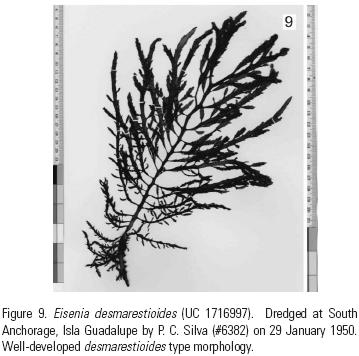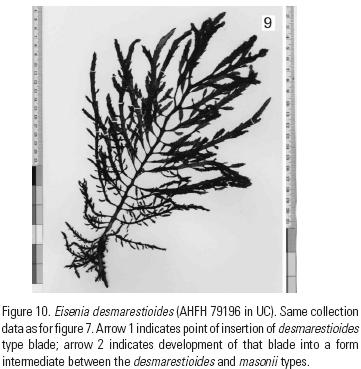Serviços Personalizados
Journal
Artigo
Indicadores
-
 Citado por SciELO
Citado por SciELO -
 Acessos
Acessos
Links relacionados
-
 Similares em
SciELO
Similares em
SciELO
Compartilhar
Hidrobiológica
versão impressa ISSN 0188-8897
Hidrobiológica vol.18 no.2 Ciudad de México Ago. 2008
Notas científicas
Conspecificity of Eisenia desmarestioides and E. masonii (Laminariales, Phaeophyceae) from Isla Guadalupe, Baja California, Mexico
Conespecificidad de Eisenia desmarestioides y E. masonii (Laminariales, Phaeophyceae) de Isla Guadalupe, Baja California, México
Paul C. Silva1
1 University Herbarium, University of California, Berkeley, CA 94720–2465, U.S.A. *E–mail: psilva@berkeley.edu
Recibido: 27 de julio de 2007.
Aceptado: 10 de julio de 2008.
RESUMEN
El examen de varios talos enteros de Eisenia de Isla Guadalupe, Baja California, México, mostró que E. desmarestioides y E. masonii, dos especies previamente descritas para la isla por Setchell y Gardner, representan formas de crecimiento de una sola especie, por lo que el nombre E. desmarestioides es retenido. Las frondas del tipo desmarestioides se desarollan inicialmente a partir de crecimientos en las partes basales de los pseudoestipes. Ellos encierran las frondas del tipo masonii, las cuales se desarollan a partir de crecimientos distales en los pseudoestipes a los desmarestioides iniciales. No se conoce el significado de este dimorfismo.
Palabras clave: Eisenia arborea, E. desmarestioides, E. masonii, Isla Guadalupe, dimorfismo.
ABSTRACT
Examination of several entire thalli of Eisenia from Isla Guadalupe, Baja California, Mexico, shows that E. desmarestioides and E. masonii, two species previously described from that island by Setchell and Gardner, represent growth forms of a single species, for which the name E. desmarestioides is retained. Desmarestioides–type blades develop from outgrowths initiated basally from pseudostipes. They subtend masonii–type blades, which develop from outgrowths initiated from pseudostipes distal to the desmarestioides initials. The significance of this dimorphism is not known.
Key words: Eisenia arborea, E. desmarestioides, E. masonii, Isla Guadalupe, dimorphism.
In Silva and Chacana (2005) the suggestion was made that Eisenia desmarestioides and E. masonii, two species described from Isla Guadalupe in the same publication by Setchell and Gardner (1930), were conspecific. The documentation for this suggestion is presented here.
All specimens used in this study are housed in the Herbarium of the University of California, Berkeley (UC), having been placed there either directly or by transfer in 1972 of the algae from the California Academy of Sciences (CAS) or by acquisition in 2004 of the algae formerly housed first at the Allan Hancock Foundation Herbarium (AHFH) and later at the Herbarium of the Natural History Museum of Los Angeles County (LAM). Herbarium specimens were scanned with high resolution and manipulated in Photoshop.
In 1925, the California Academy of Sciences (San Francisco) mounted an expedition to explore the Revillagigedo Archipelago off the Pacific coast of Mexico (Hanna 1926). The U.S. Navy generously provided the ship, the U.S.Ortolan, a mine sweeper. The botanist on the scientific staff was Herbert L. Mason, at that time Professor of Botany at Mills College, Oakland, California.
En route to the Revillagigedo Archipelago, the expedition spent three days at Isla Guadalupe (19–22 April 1925). On 20 April four dredge hauls were made from the sandy bottom of Caleta Melpómene (28º 53.2'N, 118º 16.3' W), but no kelps were retrieved. When the anchor was hoisted, however, several fragmentary blades were entangled. These fragments show varying degrees of pinnate dissection. Setchell and Gardner (1930), when studying the algae obtained by this expedition, sorted the fragments and found that all but one formed a morphological cline, varying in degree of pinnate dissection but with the pinnae consistently broad. The exceptional fragment had primary and secondary pinnae that were consistently narrow. On the broadly pinnate blades, Setchell and Gardner found sori with sporangia and paraphyses typical of members of the Laminariales. The narrowly pinnate fragment was sterile. Setchell and Gardner decided that the fragmentary blades belonged to a kelp in the family Alariaceae, possibly Eisenia. They proceeded to describe the broadly pinnate fragments as Eisenia (?) masonii and the narrowly pinnate fragment as Eisenia (?) desmarestioides. The fragments selected by those authors to illustrate the new species are strikingly different.
The fragment representing E. masonii (Fig. 1) is pinnately divided with broad dentate pinnae, the older of which are stipitate and bear small dentate pinnules. The fragment (and only representative) of E. desmarestioides (Fig. 2) has abundant pinnate divisions, the primary pinnae being long and narrow, with an abundance of long and narrow dentate pinnules.


A fragmentary blade with very long and narrow simple pinnae was collected at the same site on Isla Guadalupe by Carl L. Hubbs in August 1946 while on the Flynn–Zaca Expedition. This specimen (Fig. 5) was identified by E. Yale Dawson as E. desmarestioides. Two additional fragmentary blades (Figs. 3, 4) were collected by Hubbs in December 1946 while on the E. W. Scripps Expedition.



Both were referred to E. masonii by Dawson. The latter collection was the first to provide information on the depth of occurrence (24.5–27 fms = 45–49 m). Stewart and Stewart (1984) reported that Eisenia was the only conspicuous seaweed at depths of 20–33 m in an unmarked inlet near Caleta Melpómene that they named "Chaetodon Cove". A specimen from this collection, which was not used in this study, was deposited at CMMEX (Herbario, Facultad de Ciencias Marinas, Universidad Autónoma de Baja California).
In cooperation with the San Diego Natural History Museum, the J. W. Sefton Foundation sponsored an expedition to the islands off the coast of Baja California in January 1950, operating with the R.V. Orca. As phycologist on that expedition, I collected entire thalli of Eisenia on rocks in the upper subtidal zone at West Anchorage, Isla Guadalupe, and several more from dredge hauls taken at Caleta Melpómene. In addition, Conrad Limbaugh, the designated diver of the expedition, collected an entire thallus in Caleta Melpómene at a depth of 4–5 m. These collections confirmed that the generic placement of E. masonii and E. desmarestioides by Setchell and Gardner was correct, although the degree of dissection of the blades was unmatched in all other species of the genus.
Several entire thalli obtained by the Sefton Expedition were made into herbarium specimens. Although they pose no problem on the generic level, they raise serious questions regarding the biological validity of the two species described by Setchell and Gardner. In the development of the thallus of Eisenia, the primary blade erodes from the apex to the meristematic region, which then divides longitudinally to produce two pseudostipes. Setchell (1905) described the development of the blade of Eisenia arborea Areschoug as follows: "The basal margins of the blade begin to thicken and to turn in on one side of the frond... While this is going on the blade becomes shorter and wider, while the pinnules, or sporophylls, become longer and more toothed. After a time...the blade wears away gradually until it disappears almost entirely except for the small side pieces, ligules, each bearing a bunch of sporophylls. The bases of the ligules possess meristematic tissues. These arms may reach the length of 30 cm or more and become thickened so that they look like branches... As the arms increase in length they make a half twist, so that the portion of the ligule on which the young sporophylls are making their appearance as slight outgrowths, are pointing inward instead of outward...". In some complete thalli obtained by the Sefton Expedition (1950) and by John Hansen (1972) from Isla Guadalupe, the two pseudostipes appear to have produced very different blades, one resembling E. masonii, the other resembling E. desmarestioides (Fig. 6). Close examination of these dimorphic thalli reveals that the desmarestioides blades are initiated at the base of the pseudostipes, subtending the mass of broader masonii–type blades (Fig. 7). The basal position of the desmarestioides initials is evident even on juvenile plants, before the formation of the pseudostipes (Fig. 8). These desmarestioides initials develop either into fully desmarestoides blades (Figs. 2, 5, 9) or into blades intermediate between the masonii and desmarestioides types (Fig. 10), all with a stipe–like base.





Fertile sori occur on masonii–type blades (Figs. 3, 4), but have not been observed on desmarestioides blades. Thus, despite their specific location at the base of the pseudostipes and their strong morphological differentiation, these blades are not specialized sporophylls. This blade dimorphism has not been observed in other species of Eisenia. While the basis of the morphological variability in Eisenia spp. on Isla Guadalupe cannot be deduced without further study, it is clear that only one species is involved, for which I choose to retain the name Eisenia desmarestioides.
ACKNOWLEDGEMENTS
I thank Kathy Ann Miller for her endearing support and invaluable help in preparing this manuscript. Relying on her extensive field experience with Eisenia arborea Areschoug in the Channel Islands of southern California, she contributed significantly to an interpretation of the complex morphological variability in Eisenia desmarestioides. Max Chacana kindly provided the Spanish summary. I also want to acknowledge the generosity of the late Joseph W. Sefton, Jr., who had faith in the scientific promise of graduate students. Lastly, I express my warm memories of Conrad Limbaugh, who died in a tragic diving accident off the French Mediterranean coast (Port–Miou, near Marseilles) on 20 March 1960. Conrad introduced SCUBA diving to the west coast of the United States in 1949 and, ironically, had become an internationally known authority on underwater safety. His subtidal exploration during the Sefton Expedition was astonishing to those on board the Orca. Few of us envisioned the time when such activity was not only commonplace, but a requisite for marine biological research.
REFERENCES
Hanna, G. D. 1926. Expedition to the Revillagigedo Islands, Mexico, in 1925. General report. Proceedings of the California Academy of Sciences, Ser. 4, 15: 1–113. [ Links ]
Setchell, W. A. 1905. Post–embryonal stages of the Laminariaceae. University of California Publications in Botany 2: 115–138. [ Links ]
Setchell, W. A. & N.L. Gardner. 1930. Marine algae of the Revillagigedo Islands Expedition in 1925. Proceedings of the California Academy of Sciences, Ser. 4, 19: 109–215. [ Links ]
Silva, P. C. & M. E. Chacana. 2005. Marine algae from Islas San Félix y San Ambrosio (Chilean oceanic islands). Cryptogamie: Algologie 26: 103–118. [ Links ]
Stewart, J. G. & J. R. Stewart. 1984. Marine algae of Guadalupe Island, Mexico, including a checklist. Ciencias Marinas 10: 129–148. [ Links ]














